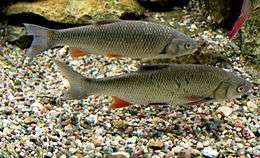European chub
| Chub | |
|---|---|
 | |
| Scientific classification | |
| Kingdom: | Animalia |
| Phylum: | Chordata |
| Class: | Actinopterygii |
| Order: | Clupeiformes |
| Family: | Cyprinidae |
| Genus: | Squalius |
| Species: | S. cephalus |
| Binomial name | |
| Squalius cephalus (Linnaeus, 1758) | |
| Synonyms | |
|
Leuciscus cephalus (Linnaeus, 1758) | |
The chub[1][2] (Squalius cephalus) is a European species of freshwater fish in the carp family Cyprinidae. It frequents both slow and moderate rivers, as well as canals and still waters of various kinds. In North America, this species is referred to as the European chub.[1]
Distribution
The species is distributed in most of the countries of Europe.[3]
Fishing for chub
European chub are popular with anglers due to their readiness to feed, and thus to be caught, in almost any conditions. Small chub are freely biting fish which even inexperienced anglers find easy to catch. As they become larger, however, chub become more wary and are easily spooked by noise or visual disturbance. Consequently, large chub (in excess of 2 kg) are keenly sought by anglers who prefer to target specific fish.
The British angling record for chub was broken in May 2007 when Steve White caught a 4.2-kg (9.2-lb) fish from a southern stillwater on a mainline boilie.[4] The chub can reach a maximum length of 60–80 cm (24-31.5 in).

Tackle and tactics
Smaller chub are not too difficult to catch and on small or medium-sized rivers, a stick-float fishing approach can be adopted or even a swim-feeder and using almost any bait including maggots, luncheon meat, sweetcorn and even small lures and flies. Catching the larger specimens however requires a patient and stealthy approach as most larger chub are caught on the smaller, clearer rivers and as a result, the angler must make their presence as subtle as possible and yet again, not a lot of tackle is required and most anglers may even set their tackle up before they get their favored spot as there is less noise from tackle being set up that may disturb the fish. A classic chub spot is just hanging off (or even inside) branches/bushes brushing through the water as chub are quite sensitive to sunlight and most anglers may fish at sunrise or sunset when the chub leave their entangled home. An angler should also look for where the current is being pushed out, causing a re-circulation pattern behind what ever is pushing the current outwards and this is where lots of food will wash around and where there will probably be feeding fish. Like with the smaller chub, a range of baits can be used but smaller baits such as maggots may attract small fish like minnows (especially on smaller rivers) so a larger bait such as luncheon meat is best used. In terms of the line setup, line ratings of a range of 4-8 pounds breaking-strain is ideal, less experienced anglers should use the tougher rating until they have gained knowledge about 'playing' the fish.
- Feeder/ledger fishing
Traditionally a quiver-tip rod is used with at least 4 pound line rating due to the weight of the ledger/feeder (heavier weights need heavier line). In feeder fishing, bait will be put on a hook and inside a swim-feeder which the current will cause to flow out and attract fish to the hook's position so it involves fishing upstream of where the fish are, this usually involves smaller baits like sweetcorn or maggots. The same applies to ledgering except there is a weight (called a ledger) instead of a swim-feeder and usually heavier baits are used here such as luncheon meat. Another method known as touch-ledgering can be used which involves not using a quiver-tip but instead holding the line that is loose off the reel and feeling for any pulls or the line going loose. Some anglers do this without any weights and let the bait slowly drift downstream with the line steadily moving through their hands, slugs and luncheon meat are excellent for this method.
- Float fishing
This method could involve fishing under the rod-tip in deep water or letting the float gently drift to where the fish may be situated (known as trotting) whilst throwing portions of bait in the stream to encourage feeding. Usually a lighter rod may be used (no more than 10 foot) and sometimes a centrepin reel is used as it allows the line to smoothly come off the reel. Anglers must strike quickly when trotting as bites can be easy to miss sometimes. Drifting baits such as bread, sweetcorn and maggots are usually used here.
- Lure fishing
This method is usually for the larger chub, a light spinning/lure rod with a fixed-spool reel of at least 10 pounds line rating as it is easy to snag onto debris when doing this method. Small lures such as bar-spoons and spoons or even small soft-plastics can imitate the smaller fish such as minnows that the larger chub feed on.
- Fly-fishing
Using flies such as damselfly patterns or even larger, dark patterns such as those that imitate slugs can be very good if presented correctly. More obvious, shiny flies that imitate small fish may work for more aggressive chub, this method is all-year but best in warmer months. Nymph patterns also do well.
References
- 1 2 Froese, Rainer and Pauly, Daniel, eds. (2012). "Leuciscus cephalus" in FishBase. 5 2012 version.
- ↑ World Conservation Monitoring Centre 2010. Squalius cephalus. 2008 IUCN Red List of Threatened Species. Archived June 27, 2014, at the Wayback Machine. Downloaded on 5 April 2010.
- ↑ Squalius cephalus. 2008 IUCN Red List of Threatened Species. Downloaded on 5 April 2010.
- ↑ "Chub Record Broken - FishingMagic Catch Reports".
